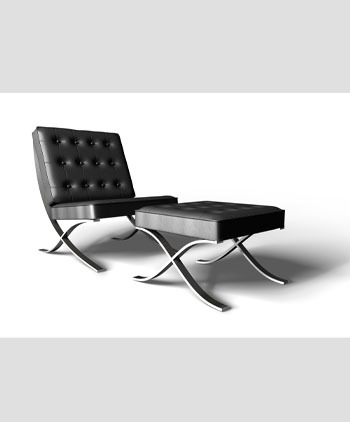Bauhaus Furniture History: The Revolution That Changed Modern Design
Apr 21st 2025

As you sit in a tubular steel armchair or gaze at the spare lines of a streamlined bookshelf, you're witnessing the radical influence of Bauhaus furniture history at work. In 1919, a small German art school spawned a design revolution that would transform the interiors and exteriors of our homes, workplaces, and public spaces.
By its pioneering philosophy that "form follows function," Bauhaus design aesthetics eliminated the need for ornament and accepted the design potential of new industrialized materials. Today, more than a century later, these pioneering designs remain as vibrant and up to the minute as when scandalizing the design community they initially emerged.
Why did this revolution last for so long? And how did a tiny cohort of visionary Bauhaus furniture designers make the mundane objects we surround ourselves with daily timeless icons?
The Origins of Bauhaus Furniture
The Bauhaus school arose in the post-World War I era when Germany had embarked on rebuilding its national identity and economy. The Bauhaus, or "house building," had been established in 1919 in Weimar, Germany, by architect Walter Gropius to reunite fine arts and functional design under the same roof.
Before the Bauhaus, furniture had been mainly elaborate, expensive, and bespoke for the elite class. The Industrial Revolution had created mass-manufactured furniture, but much of it was poorly imitating the classic shapes, creating low-quality copies with no craftsmanship or the actual design.
Gropius dreamed up a new harmony between technology, craft, and art. In his Bauhaus manifesto, he wrote: "The ultimate aim of all visual arts is the complete building!" Naturally enough, this philosophy was applied to furniture design, too, because Bauhaus considered furniture an integral component of modern architecture and interiors.
Bauhaus Furniture Designers Who Shaped Modern Interiors
A visionary group of designers drove this groundbreaking furniture design with a passion and technical innovation that transformed interiors forever.
The most significant Bauhaus furniture designer, Marcel Breuer, entered as a student and emerged as a master at the school. Inspired by the tubular steel that formed the handlebars on his bicycle, Breuer became the first person to apply bent steel tubing to furniture. At the time, this form was considered too industrial to be found inside the home.
Ludwig Mies van der Rohe added an architectural discipline to the furniture design style. "Less is more" was his classic phrase, the Bauhaus principle of leaving out all that wasn't essential. The chairs and furniture designs by Mies van der Rohe balanced structural beauty with perfect proportion.
Marianne Brandt, better known for her metalwork, created pieces that reflected the Bauhaus philosophy of function and industrial look. One of the women who struggled to be admitted to the metal workshop, which numbered few, brought a new sensitivity to industrial materials to the field.
Josef Albers, who taught beginning courses at the Bauhaus, designed furniture that reflected his respect for form and the geometry of the material. His stack tables, with their simple lines and impeccable proportions, are the personification of the Bauhaus principle that form and function could be harmoniously united.
She directed the weaving class, and although she wasn't a furniture designer, her textile innovations influenced the direction that Bauhaus furniture took with textile elements, particularly with chairs.

Bauhaus Chairs History: Evolution of Functional Seating
The chair became the ultimate Bauhaus design philosophy canvas—a deceptively simple form that posed the solution to complicated issues of structure, comfort, and mass production. The history of Bauhaus chairs' development stands as the best model of the school, changing the way we think about design.
Early-1920s Bauhaus chairs remained rooted in traditional craft and expressivist inclinations. Marcel Breuer's African Chair (1921), which he designed with textile artist Gunta Stölzl, featured colored woven strips and wood joinery, which were not remotely characteristic of his future modernist output.
The genuine revolution during the Bauhaus era arrived with Breuer in 1925 when he designed his inaugural tubular steel chair, the Wassily (Model B3). Based on the form of bicycle handlebars, the chair relegated the traditional chair to the structural skeletal form. The leather straps supported the unbroken steel frame, creating a weightless-looking but de facto comfortable and sturdy piece.
This creation led the way to an era of vast experimentation with industrial materials. Mart Stam designed the first cantilever chair using gas pipes, and his sleek Brno Chair perfected the style with the seemingly impossible-looking supporting mechanism that seemed to make the chair hover in the air.
By 1928, Breuer had refined his method with the Cesca Chair (B32), combining the cantilever principle with a tube frame and back and seat in cane. In this work, Breuer achieved the ultimate synthesis of industrial manufacture and individual comfort—the cool metal set against the natural heat of cane to perfect effect.
Bauhaus chairs' development progressed in a specific direction:
-
Simplified form reduction
-
Higher structural innovation
-
Efficient use of materials
-
Increased opportunities for mass production
-
Greater comfort through scientific insights on ergonomics
These innovations went far beyond being superficial—they represented an entirely new design for the manufacture of furniture. Traditional chairs required complicated joinery and skillful craftsmen, making them expensive and laborious to produce. Bauhaus chairs could be manufactured with mass-produced components requiring little skill, making quality design accessible to the masses.
The social impact of the policy was radical. According to Gropius, "The Bauhaus considers the machine as the medium for modern design and aims to come to terms with it." In accepting production on the industrial level, the history of Bauhaus chairs is the site where modern design might be democratic, not elite.
Iconic Bauhaus Chairs: Famous Bauhaus Designs Available Today
Cesca Chair
Marcel Breuer's Cesca Chair, created in 1928, is the quintessential integration of the Bauhaus ideal. This cantilevered model, named by Breuer after his daughter Francesca, combines industrial steel tubing with conventional cane work, blending machine age with natural materials in harmony.
Wassily Chair
Breuer's Wassily Chair, Model B3, designed in 1925, is the most recognizable of all the iconic Bauhaus designs. Designed when Breuer directed the Bauhaus furniture department, the chair got the name of its namesake, Breuer's co-worker Wassily Kandinsky, when, visiting Breuer's studio, the latter saw the design for the first time.
Brno Chair
Ludwig Mies Van Der Rohe's Brno Chair, designed by him in 1930 for the Tugendhat House, Brno, Czech Republic, is a classic representation of his famous "less is more" philosophy. The cantilever structure gives the chair the illusion that the user hangs in the air on a single, unbroken piece of tubular or sheet steel.
Bauhaus Furniture Characteristics: What Defines the Style?
Function Dictates Form
The central principle of Bauhaus furniture is that form must derive from function, not form and function rooted in tradition and decoration. The form must be assigned a functional purpose, with nothing irrelevant or strictly for show.
Truth to Material
Bauhaus designers believed in honoring the natural qualities of materials rather than camouflaging their properties. Steel remained steel that could be visible, wood remained wood, and leather remained leather.
Geometric Simplicity
Simplistic and geometric forms dominate Bauhaus furniture, with circles, squares, and rectangles dominating, leaving unduly complicated curves only where necessary functionally. This orderliness via geometry creates the objects' sense of visual order and their timeless quality, partly due to the elimination of all forms that aren't necessary.
Industrial Material
The utilization of industrial materials—tubular steel, glass, and plywood—is characteristic of Bauhaus furniture. These materials had hardly been utilized in home furniture previously, and their use was a radical departure from the conventional furniture made essentially of solid wood.
Visual Lightness
Bauhaus furniture tends to convey the illusion of visual lightness and transparency. Tables and chairs look like they are floating, with little visual mass but still maintaining structural stability. This quality makes Bauhaus furniture precious in tiny rooms where heavy furniture would be oppressive.
Ergonomic Considerations
Though not necessarily explicit, Bauhaus furniture featured the beginnings of ergonomics. Proportions, heights, and angles all existed to safely accommodate the body, a scientific method that diverged from furniture proportions based mainly on aesthetics alone.
Experience Bauhaus Design at Seats & Stools
The revolution that began at a German school of art over a century ago affects how we live today. The values espoused by Bauhaus furniture design history—functional beauty, honesty of material, and democratic availability—could hardly be more pertinent in the complexities we live with nowadays.
Looking for Bauhaus furniture? Contact Seats & Stools today and arrange a complimentary consultation with one of our designers. Discover how the Bauhaus style can bring timeless modernity to your home, office, or commercial building.

